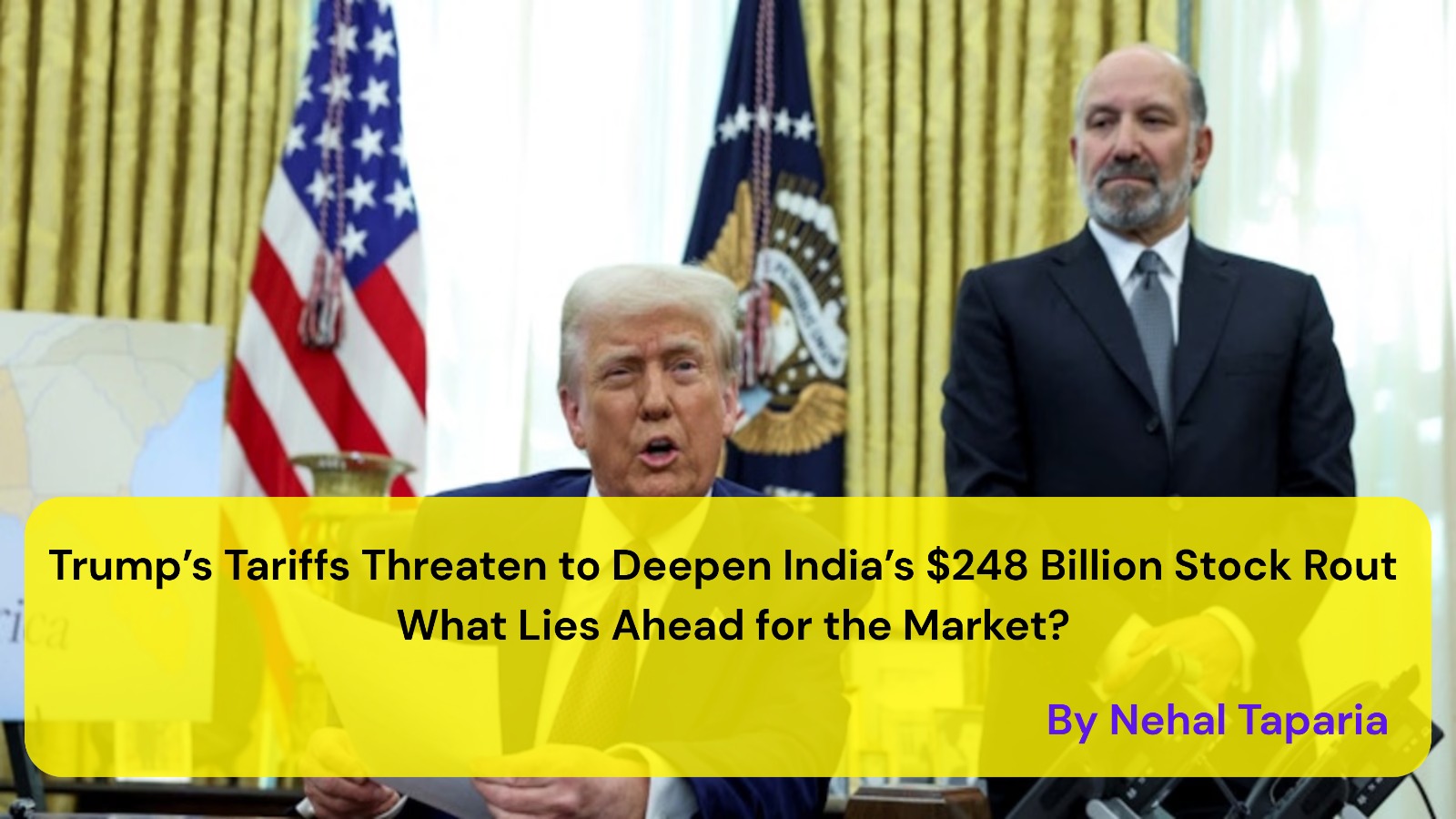Trump’s Tariffs Threaten to Deepen India’s $248 Billion Stock Rout — What Lies Ahead for the Market?

Trump’s Tariffs Threaten to Deepen India’s $248 Billion Stock Rout — What Lies Ahead for the Market?
India’s stock market has recently been rocked by mounting fears of external geopolitical shocks—chief among them, Trump’s announcement of 25% tariffs on Indian exports. The news comes amid already fragile investor sentiment and a steep correction across sectors. Over the past few weeks, Indian equities have lost $248 billion in market capitalization, raising red flags for both domestic investors and foreign institutions.
Now, Trump’s protectionist tariff stance may further dent India’s export-led sectors and weigh down corporate earnings, making the equity market even more vulnerable.
What’s Driving the Market Selloff?
1. Tariff Shock and Trade Tensions
The announcement of a 25% blanket tariff on Indian exports by former U.S. President Donald Trump has alarmed the global investor community. The move, framed as a retaliatory measure against India’s trade policies and its strategic ties with Russia, threatens India’s competitive edge in:
- Pharmaceuticals
- Textiles and apparel
- Engineering goods
- Gems & jewellery
- Auto components
This uncertainty is leading to capital outflows and selling pressure across sectors with U.S. exposure.
2. Sectoral Earnings Risk
Sectors like IT, pharma, and auto parts, which derive a large portion of their revenue from U.S. markets, are expected to see earnings pressure due to lower exports and potential demand decline.
3. FII Selling
Foreign Institutional Investors (FIIs) have been net sellers recently, citing global uncertainties and valuation concerns. The U.S. tariff stance adds another layer of risk, leading FIIs to pull capital out of Indian equities and shift toward safer assets or alternative emerging markets.
Impact on Indian Stock Market
|
Impact Area |
Expected Outcome |
|
Market Capitalization |
Already lost $248 billion and could slide further |
|
Nifty & Sensex |
Under pressure; likely to test key support levels |
|
Export-Oriented Stocks |
Likely to remain weak; IT, pharma, textiles, and autos most vulnerable |
|
Investor Sentiment |
Cautious to bearish in short term |
|
Currency Impact |
INR may depreciate due to lower capital inflows and rising trade risk |
Sector-Wise Breakdown
Pharma
- Tariffs could increase U.S. drug prices, leading to regulatory tightening.
- Indian generic players may lose price competitiveness.
- Stocks like Sun Pharma, Lupin, and Cipla are likely to feel the heat.
Textiles & Apparel
- Indian exporters already face stiff competition from Bangladesh and Vietnam.
- The tariff further erodes cost advantages, risking market share loss.
Gems & Jewellery
- With ~36% of CPD (cut and polished diamonds) exports heading to the U.S., this segment faces direct earnings risk.
Auto Components
- India exports over 25% of auto components to the U.S.
- Margins will come under stress as input costs stay elevated and volumes fall.
What Lies Ahead?
The correction in Indian markets could deepen unless diplomatic solutions are found. However, there may be a silver lining if:
- The Indian government negotiates tariff rollbacks through trade dialogues.
- Exporters successfully diversify their markets toward Europe, the Middle East, and Southeast Asia.
- Domestic reforms and stimulus measures revive internal consumption and offset global headwinds.
Meanwhile, volatility will remain high, and traders/investors are advised to adopt a cautious approach, especially in sectors with direct U.S. exposure.
Conclusion
Trump’s tariff threat is a major external shock at a time when Indian markets were already vulnerable. While the $248 billion rout is significant, the bigger question is how policymakers, corporates, and investors adapt. With thoughtful diplomacy, strategic diversification, and focused reforms, India can manage this challenge. But in the near term, volatility and caution will dominate the Indian stock market landscape.
By Nehal Taparia
This content is for educational and knowledge purposes only and should not be considered as investment or Trading advice. Please consult a certified financial advisor before making any investment or Trading decisions.
Our Recent FAQS
Frequently Asked Question &
Answers Here
Q1: Why are Trump’s tariffs such a big deal for Indian markets?
Because they directly impact high-export sectors like pharma, textiles, and IT—major components of Indian indices. The tariffs reduce competitiveness and earnings, triggering market-wide selling.
Q2: How much market value has India lost already?
Q3: Will this trigger a longer-term bear market?
Q4: What should investors do right now?
Q5: Can the Indian government do anything to mitigate this?
Copyright © By Empirical F&M Academy. Design & Developed by Techno Duniya


.jpg)


.jpeg)




